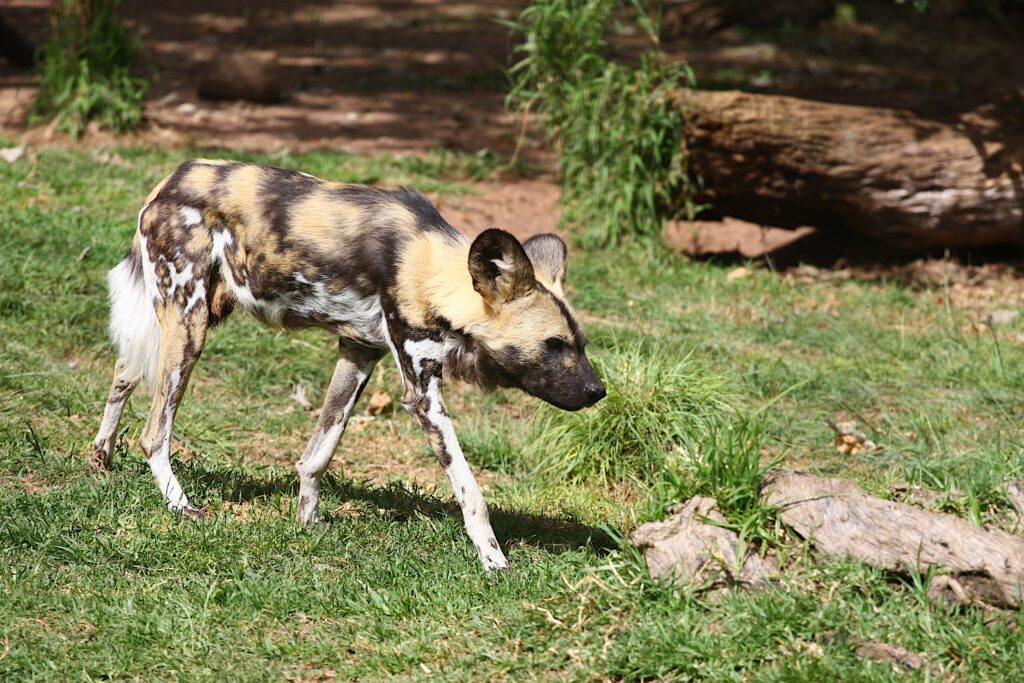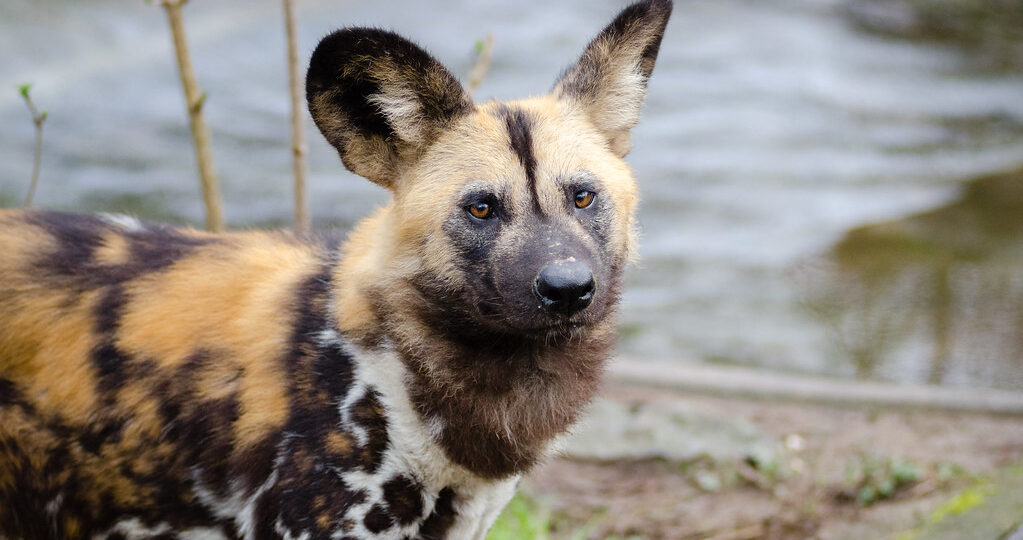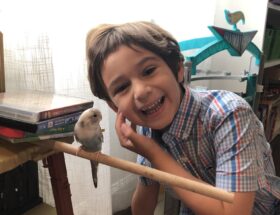


Quick and Easy Navigation
Fun Facts About The African Wild Dog AKA the Painted Wolf
The African Wild Dog, also known as the painted wolf or painted dog, is one of the most endangered mammals in the world. Listed in the IUCN Red List as critically endangered, and their population is declining. Their biggest threats are conflicts with humans, such as local farmers who fear for their livestock, and other predators. Also, their population is fragmented further increasing the threat to their survival.
African Wild dogs are important to the world because they play an essential part in the biodiversity of Africa. They promote a healthy ecosystem by weeding out the sick or injured animals, promoting the survival of the fittest. They also compete with other predators, effectively limiting their populations. Luckily there are many organizations working towards conservation efforts to save these mammals!
15 Painted Wolf Facts
- The African Wild Dog or Painted Wolf is a canine native to the sub-Saharan region in Africa. It is the only extant member of the genus, Lycaon.
- They are found mostly in Southern Africa in the Forests, Grasslands, and Deserts of Tanzania and Mozambique.
- They can weigh up to 70 pounds, measure up to 56 inches long and 30 inches tall.
- They have brown, black, and white fur, and their markings are unique to each.
- Yes! You read that right; they have four toes. They have long legs, strong jaws, and round ears. They have a superb sense of hearing and smell that helps them track down prey.
- They are carnivores and hunt for medium-sized common antelopes and gazelles. They supplement their diets with rodents and birds.
- They have strong premolars for crushing meat and bones.
- They are one of the most successful hunters in the world, 4 out of 5 chases are successful. They learn this skill from the pack.
- They can reach speeds of up to 44 MPH.
- They are highly social animals and live in packs between 10 to 40 members.
- The pack dominating breeding pair female has a litter of between 2 to 20 pups, which are cared for by the entire pack.
- They also hunt in packs and have been observed sharing food, assisting the weak or ill members, and communicating by touch, movement, and vocalizations.
- Teamwork is their most important survival adaptation!
- They can live up to 11 years in the wild.
- The painted wolf population is estimated to be around 1,400.
African Wild Dog, Painted Wolf Conservation Status
The Painted Wolf, also known as the African wild dog or African painted dog, is currently listed as Endangered on the IUCN Red List of Threatened Species. The species faces significant threats that have resulted in a drastic decline in its population. Currently, there are approximately 6,500 painted wolves left in the wild. The primary challenges to their survival include habitat loss, diseases like rabies and distemper, and competition with other large predators. Efforts by various conservation organizations are underway to protect and increase their numbers, but the risk of extinction remains a pressing concern for this unique and ecologically important species
The Misunderstood Names of Africa’s Painted Wolves
The African wild dog (Lycaon pictus) is a fascinating yet increasingly threatened species found across sub-Saharan Africa. Also known as the painted wolf, Cape hunting dog, and African hunting dog, this remarkable carnivore has been burdened with misnomers and misconceptions throughout history. With only around 6,600 individuals left in the wild, promoting a deeper understanding of the painted wolf is crucial to ensuring its conservation.
A Complex History of Names
The painted wolf has amassed an extensive collection of common names in English alone:
- African wild dog
- Cape hunting dog
- Hunting dog
- African hunting dog
- Wild dog
- Hyena dog
- Painted dog
- Painted hunting dog
- Painted wolf
- Ornate wolf
This diversity of titles reflects the complex relationship humans have had with these opportunistic predators. Their reputation as ruthless killers of livestock led to persecution by farmers and their indiscriminate elimination across much of their range. As a result, painted wolves were eradicated from most of South Africa by the early 1900s.
An Inaccurate Association with Hyenas
One of the most misleading names pinned on the painted wolf is the “hyena dog.” This false association reflects a long-running confusion between painted wolves and hyenas. While hyenas are members of the Hyaenidae family more closely related to cats and mongooses, painted wolves belong to the Canidae family alongside wolves, dogs, coyotes, jackals, and foxes.
Despite not being closely related, hyenas and painted wolves fill similar ecological roles as highly mobile predators and opportunistic scavengers. This convergence likely contributed to their reputations as pests worthy of elimination.
The Wolf Connection
In contrast to the misnomer “hyena dog,” the names “painted wolf” and “ornate wolf” accurately reflect the species’ evolutionary relationship with wolves. Recent genetic analysis revealed painted wolves share a common ancestor with the grey wolf and are more closely related to wolves than domesticated dogs.
Painted wolves display remarkably wolf-like behavior as well. They live in hierarchical packs with a breeding alpha pair directing group movements and activities. Packs even howl and mark territory with scent like wolves.
Social Structure
Painted wolves live in close-knit packs dominated by a monogamous breeding pair. The alpha male and female direct the movements and activities of the group.
Their complex vocalizations also parallel wolves, with pack members yipping and howling to communicate. Scent marking through bodily excretions allows them to claim territory as well.
Given their close evolutionary kinship and behavioral similarities with wolves, the names “painted wolf” and “ornate wolf” suit this species well.
The Significance of Scientific Names
The painted wolf’s scientific name provides key insights into its identity. Lycaon pictus translates from Greek and Latin as “painted wolf-like animal.” This aptly describes the species’ physical resemblance to wolves and distinctive patchy fur patterning.
The scientific name also classifies painted wolves within:
- Genus: Lycaon
- Species: pictus
This taxonomy reflects the painted wolf’s placement within the Canidae family’s Lycaon genus as the single surviving species pictus.
Shifting Attitudes Through Thoughtful Names
With only around 6,600 painted wolves remaining across Africa, the species is classified as Endangered by the IUCN Red List. These iconic yet imperiled predators warrant serious conservation attention.
Many advocates believe referring to painted wolves by their more accurate and majestic names could engender greater appreciation for the species’ unique traits and precarious predicament. As Attenborough’s Dynasties team aimed to do through their respectful portrayal of painted wolves, positive messaging and terminology can potentially transform perceptions and save wildlife.
Conclusion
The African painted wolf’s diverse array of common names conveys a complicated history intertwined with humans. While some titles like “hyena dog” are blatantly misleading, “painted wolf” and “ornate wolf” accurately reflect the species’ evolutionary kinship with wolves. Along with its scientific name Lycaon pictus, these respectful terms help convey the painted wolf’s distinctive nature as Africa’s only wolf-like canid. Wider adoption of such precise terminology could aid conservation efforts vital to ensuring the painted wolf’s survival.
African Wild Dogs or Painted Wolf FAQ
Q: What are African wild dogs also known as?
A: African wild dogs are also known as painted wolves.
Q: What is the scientific name for African wild dogs?
A: The scientific name for African wild dogs is Lycaon pictus.
Q: What is the typical coat pattern of African wild dogs?
A: African wild dogs have a mottled coat pattern that is unique to each individual, similar to fingerprints in humans.
Q: What is the social structure of a pack of African wild dogs?
A: African wild dogs live in packs with a highly organized social structure. Each pack has an alpha male and an alpha female that are the leaders.
Q: What are the main threats to African wild dog populations?
A: African wild dogs face threats from habitat loss, human-wildlife conflict, and infectious diseases such as rabies.
Q: Where can African wild dogs be found?
A: African wild dogs are primarily found in sub-Saharan Africa, with strong populations in countries like Zimbabwe and Botswana.
Q: How are African wild dogs different from domestic dogs?
A: African wild dogs, although related to domestic dogs, have unique hunting and social behaviors that distinguish them from their domestic counterparts.
Q: What is the status of the African wild dog population?
A: African wild dogs are classified as an endangered species, with their population numbers dwindling, making them one of Africa’s most endangered carnivores.
Q: Why are African wild dogs often referred to as painted dogs?
A: African wild dogs are often referred to as painted dogs due to their unique, mottled coat pattern, which sets them apart from other wild canids.
Q: Are there any conservation efforts focused on African wild dogs?
A: Yes, there are several conservation initiatives dedicated to protecting African wild dogs, such as the Painted Dog Conservation and National Geographic’s efforts to raise awareness about their plight.
SAVE FOR LATER











[…] Mammals, Wildlife […]
[…] Mammals, Wildlife […]
[…] Mammals, Wildlife […]